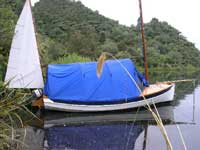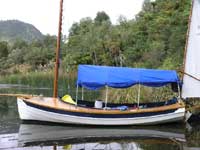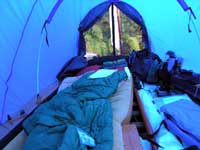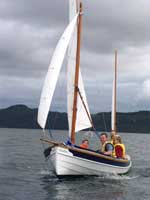|
Boomtent |

|
|
By John Leathwick - Auckland, New Zealand |
Several people expressed interest in knowing details of the boom tent
I had made for my Navigator, so here goes.
I've sent three pictures as examples: one with the fly right over and tied down for the night, one
with the sides tied up, and the third inside (not very ship-shape)
showing the attachment details. This has full standing head-room at
the forward end, and we sleep on a couple of air beds placed in the
back with a frame filling in the aft cockpit opening. We were caught
out in winds gusting to probably 20 knots the night before last, and
although it shook and shivered, it stayed intact, helped I think by
the giving nature of the frame that allows the whole structure to flex
before the wind.
 |
with the fly right over and tied down for the night
(click images for larger views) |
|
The frame consists of four lengths of 14 mm wide sail batten material
with standard glue on ends, that enable each piece of batten to be set
up in a semi-circle like the hoops of an old-time covered wagon. I
have short pieces of cord on both ends of each length of batten, and
these are used to attach each to the boat as follows, going from back
to the front:
Batten one (2300 mm long) attaches to a pair of horn cleats mounted on
the decks either side at the back of the boat about 120 mm forward
from the transom;
Batten two (2800 mm long) attaches to a pair of raised rowlock mount
blocks that sit about 70 mm above the deck and 1200 mm forward from
the transom;
Batten three (3100 mm long) attaches to the jib cleats, 2000 mm
forward of the transom;
Batten four (3000 mm long) attaches to the jib sheet fairleads, 2800
mm forward of the transom.
with the sides tied up
|

|
|
The cover is made of rip-stop nylon sewn from two pieces with the seam
running across the boat – important for avoiding leaks when it rains.
The length of the ridge line is 2650 mm. Four sewn-in pockets for the
battens run across the fly parallel to the transom at the appropriate
position, but are only sewn into the central 1500 mm of the cover (750
mm either side of the centre line). This means that the fly is not
attached to either of the lower ends of the battens so that the sides
of the fly can be raised for ventilation, a very nice feature on a
warm evening or for a relaxed but protected breakfast – Velcro ties
keep them in place when raised - see photo above.
The fly has a full width door at the back with a vertical central zip,
an insect-proof inner door, and Velcro ties to hold them back when not
needed. A similar door is located at the front set on the same side as
my anchor roller – in theory I figure I could get at the anchor at
night or the outboard out the back without dropping the cover, but
this remains untested in practice.
 |
inside (not very ship-shape)
showing the attachment details |
|
Once the battens are tied on at one end, I thread them through their
pockets and tie the other ends of the battens down to their attachment
point. An offset Velcro strap then goes around the mizzen mast at the
back, and a tape and nylon snap clip go around the main mast.
Finally, a piece of bungee that runs right around the outer edge of
the fly is clipped under standard tie-down hooks placed on the outside
of the boat just below the gunwale in line with each batten. The
bolt-rope runs across the deck at the back but is not attached to the
doors. At the front it is sewn in all the way the edge of the fly and
runs up over the gunwale, forward diagonally across the deck and sits
snugly around the front of the coaming, the forward angle of the
latter holding it firmly in place.
| HauTai, our Welsford designed Navigator with a bone in her teeth. |

|
|
Ventilation is no trouble with the insect proof doors, although it
encloses such a large volume that even with the doors all shut, and
the bottom edges of the back doors sealed off with a towel to keep out
any errant mozzies, I don't have ventilation problems - well not on
warm nights anyway.
Happy sailing
John

|